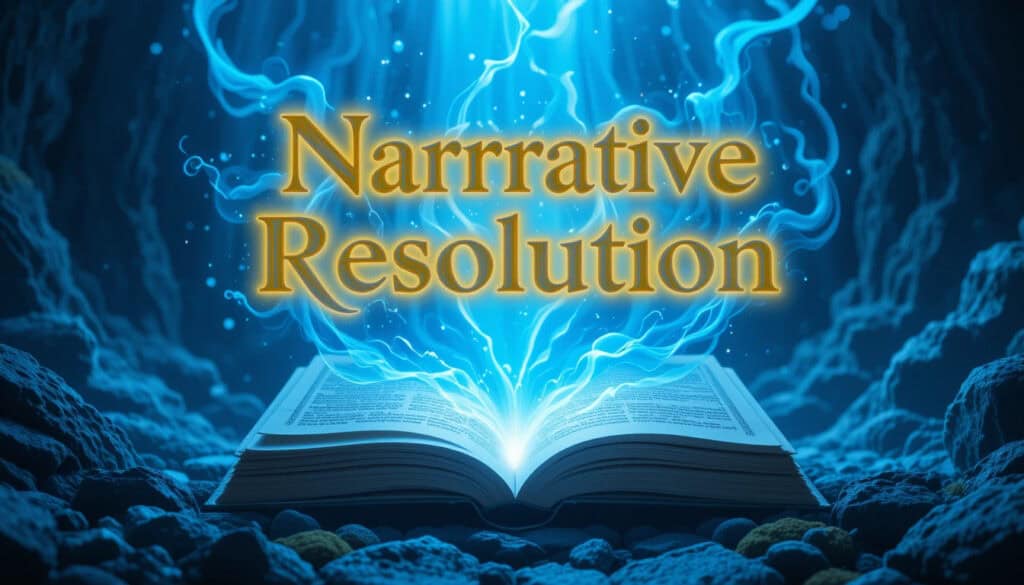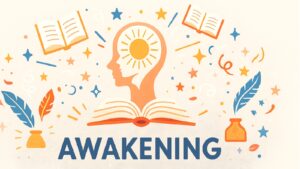Table of Contents
Introduction: Why Narrative Resolution Feels Like Emotional Truth
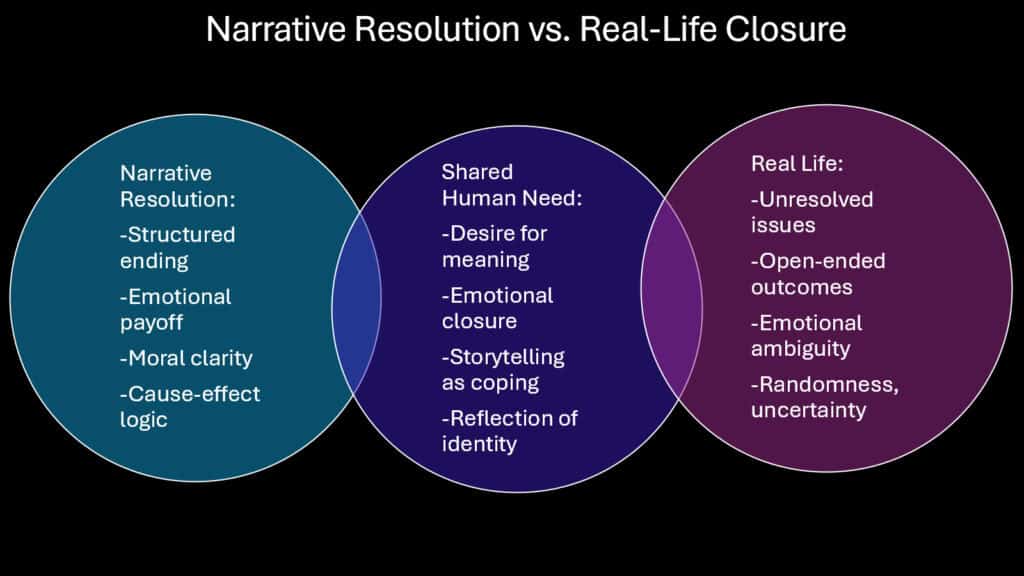
Something profound happens when we close a book after reading its final page. The satisfaction we feel isn’t just about finishing a story—it’s about experiencing the kind of closure that real life rarely provides. We live in a world of unfinished conversations, unresolved conflicts, and questions that hang in the air like morning fog. Yet within the pages of literature, we find what psychologists call narrative resolution: the structured completion of emotional and dramatic arcs that gives meaning to chaos.
Narrative resolution represents more than simple storytelling technique. It mirrors our deepest psychological need to make sense of experience, to find patterns in randomness, and to achieve emotional equilibrium. When Hamlet finally speaks his last words or when Elizabeth Bennet accepts Darcy’s proposal, we experience a form of vicarious healing that our everyday lives often deny us. These moments of resolution activate the same neural pathways that seek closure in our personal relationships and internal struggles.
The human brain craves completion. Psychologists have documented this through the Zeigarnik effect, which shows how unfinished tasks occupy more mental space than completed ones. Stories provide artificial completion for the endless loops of worry and wonder that characterize human consciousness. They offer what life withholds: clear beginnings, purposeful middles, and satisfying endings that transform confusion into understanding.
This article explores six distinct ways narrative resolution brings psychological closure. We’ll examine how cathartic release heals emotional wounds, how story structure organizes mental chaos, how archetypal patterns tap into collective comfort, how character resolution mirrors our internal conflicts, how transformational journeys affirm personal growth, and how fictional endings help separate imagination from reality. Each mechanism reveals something essential about why humans have always gathered around fires to tell stories—not just for entertainment, but for the psychological nourishment that only structured narrative can provide.
| Elements of Resolution | Psychological Function | Reader Impact |
|---|---|---|
| Conflict Resolution | Reduces cognitive dissonance | Emotional relief and satisfaction |
| Character Arc Completion | Provides vicarious growth | Sense of personal development |
| Thematic Closure | Clarifies meaning and purpose | Intellectual understanding |
| Emotional Catharsis | Releases suppressed feelings | Psychological cleansing |
| Symbolic Resolution | Connects to universal patterns | Deep subconscious comfort |
| Narrative Structure | Organizes chaotic experience | Mental order and clarity |
1. Narrative Resolution as Catharsis and Healing
Aristotle understood something fundamental about human nature when he wrote about catharsis in his Poetics. He observed that witnessing tragedy didn’t simply entertain audiences—it purged them of pity and fear through a process of emotional release. This ancient insight remains relevant today as we consider how narrative resolution functions as a form of psychological healing. When stories reach their conclusions, they don’t just end—they cleanse.
The mechanism works through identification and release. Readers invest emotional energy in characters who face conflicts similar to their own suppressed anxieties. As these fictional figures navigate their struggles toward resolution, readers experience a safe form of emotional processing. The tension builds alongside the character’s journey, creating what psychologists call optimal anxiety—enough stress to engage the system without overwhelming it. When resolution arrives, the release feels both earned and healing.
Consider how Sophocles crafted the ending of Oedipus Rex. The tragic king’s discovery of his true identity creates unbearable tension, yet his subsequent self-punishment and exile provide a form of moral clarity that audiences find strangely satisfying. The narrative resolution doesn’t offer happiness, but it provides something more valuable: the sense that justice and truth have prevailed despite human limitations. This pattern of tension followed by moral resolution activates what neuroscientists call the brain’s reward system, releasing dopamine and creating lasting satisfaction.
Modern trauma therapy often employs narrative techniques that mirror this classical cathartic process. Therapists encourage patients to tell their stories with clear beginnings, middles, and ends, helping transform chaotic experiences into structured narratives. The act of resolution—even in therapy—provides the same psychological relief that readers experience when fictional conflicts reach meaningful conclusions. The story becomes a container for emotions that might otherwise remain overwhelming and unprocessed.
| Aristotelian Cathartic Elements | Psychological Process | Therapeutic Value |
|---|---|---|
| Pity (for the character) | Emotional identification | Validates personal suffering |
| Fear (of similar fate) | Recognition of vulnerability | Acknowledges universal human frailty |
| Purification through suffering | Vicarious processing of pain | Transforms trauma into wisdom |
| Moral clarity through consequence | Cognitive resolution of ethical confusion | Restores sense of justice and meaning |
| Acceptance of human limitation | Integration of life’s tragic elements | Promotes psychological maturity |
2. Narrative Resolution Organizes Chaos Into Meaning
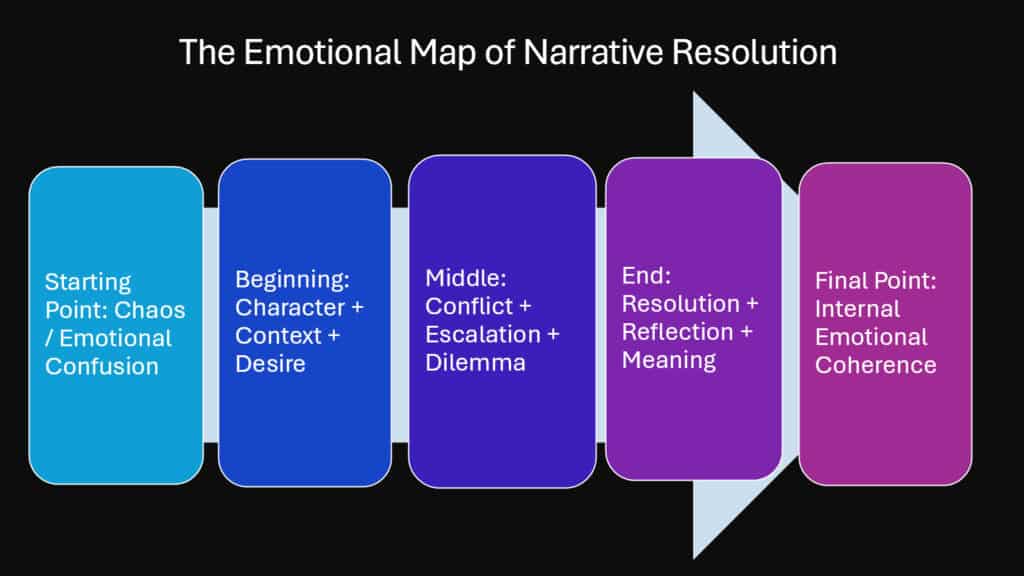
Life presents itself as a series of random events, unexpected encounters, and seemingly meaningless coincidences. We wake each morning uncertain what the day will bring, and we sleep each night with loose ends trailing behind us like shadows. Stories, however, provide what psychologist Jerome Bruner called “narrative thinking”—a way of organizing experience that creates coherence from confusion. When the characters of the stories reach resolution, they demonstrate how seemingly random events can connect into meaningful patterns.
The human mind naturally seeks pattern and causation. We look for relationships between events, searching for the threads that connect cause to effect. Stories satisfy this cognitive hunger by presenting carefully structured sequences where actions lead to consequences and characters make choices that drive toward inevitable conclusions. Even when those conclusions surprise us, they feel right in retrospect because they emerge from the logic of everything that came before.
Think about how mystery novels work. They begin with chaos—a crime that shatters normal order. Clues accumulate like scattered puzzle pieces, each one meaningless in isolation. But as the detective gathers information and the narrative moves toward resolution, these fragments suddenly coalesce into a complete picture. The moment of revelation doesn’t just solve the crime; it transforms random details into a coherent system of meaning. Readers experience profound satisfaction because their minds have participated in creating order from disorder.
This organizational function of narrative resolution extends beyond fiction into how we process our own experiences. People naturally structure their memories as stories, with clear protagonists, conflicts, and resolutions. When we tell others about our day, we unconsciously edit events into narrative form, emphasizing moments of tension and resolution while glossing over mundane transitions. This storytelling impulse serves a crucial psychological function: it helps us believe that our lives have direction and meaning rather than being mere sequences of random occurrences.
| Narrative Organization Elements | Psychological Function | Meaning-Making Process |
|---|---|---|
| Chronological Structure | Imposes temporal order on memory | Creates sense of progression and development |
| Causal Relationships | Links events through cause and effect | Establishes logical connections in experience |
| Character Motivation | Explains behavior through internal logic | Makes human actions comprehensible |
| Thematic Coherence | Unifies disparate elements around central ideas | Provides overarching purpose and significance |
| Narrative Resolution Through Consequence | Shows outcomes result from earlier actions | Demonstrates that choices and events matter |
3. Narrative Resolution Through Closure Archetypes
Carl Jung recognized that certain patterns appear repeatedly across cultures and throughout history, embedded so deeply in human consciousness that they seem to emerge from what he called the collective unconscious. These archetypal patterns include familiar figures like the wise mentor, the innocent child, and the transformative journey from ignorance to knowledge. When stories employ these ancient patterns in their narrative resolutions, they tap into psychological structures that predate individual experience, providing comfort through recognition of universal themes.
The power of archetypal narrative resolution lies in its familiarity. Even when we encounter a story for the first time, certain endings feel inevitable and satisfying because they follow patterns our minds recognize at a subconscious level. The hero’s return home after completing a quest, the death and rebirth cycle that transforms suffering into wisdom, the mentor figure who provides final guidance before disappearing—these patterns resonate because they mirror the fundamental rhythms of human experience.
Consider how many stories conclude with the archetype of renewal and return. The protagonist ventures into unknown territory, faces challenges that transform their understanding, and returns to their community bearing new wisdom. This pattern appears in narratives as diverse as The Odyssey, The Lord of the Rings, and Star Wars because it reflects something essential about human psychological development. We all face periods of confusion and growth, and we all hope to integrate new understanding into our ongoing lives.
Jung observed that these archetypal patterns function as organizing principles for the psyche. When stories resolve through familiar archetypal conclusions, they provide what he called “psychological containment”—a sense that individual experience fits within larger, meaningful patterns. The narrative resolution doesn’t just end the particular story; it connects that story to the eternal human story, offering reassurance that our own struggles and transformations participate in something larger than ourselves.
| Jungian Resolution Archetypes | Psychological Function | Universal Appeal |
|---|---|---|
| The Hero’s Return | Integration of new knowledge with community | Validates personal growth and social belonging |
| Death and Rebirth | Transformation through suffering | Provides hope for renewal after loss |
| The Wise Elder’s Guidance | Access to accumulated wisdom | Offers comfort through mentorship and tradition |
| The Sacred Marriage | Union of opposites | Represents psychological wholeness and completion |
| The Journey to the Center | Discovery of authentic self | Affirms the value of self-knowledge and inner work |
4. Narrative Resolution Mirrors Our Internal Conflicts

Every compelling character faces an internal struggle that mirrors the contradictions we carry within ourselves. We identify with fictional protagonists not just because of their external adventures, but because their inner conflicts reflect our own psychological tensions. When these characters achieve internal resolution, we experience a form of vicarious healing that helps process our own unresolved emotional dilemmas.
The most satisfying character arcs involve transformation at the psychological level. External plot events serve primarily to create pressure that forces internal change. Elizabeth Bennet must overcome her prejudice while Darcy confronts his pride. Ebenezer Scrooge faces his isolation and cruelty. Harry Potter comes to terms with the concepts of love and sacrifice. In each case, the story’s narrative resolution depends not on external victory but on internal growth that resolves fundamental psychological conflicts.
This mirroring effect works because readers unconsciously map fictional conflicts onto their own emotional struggles. When we read about characters wrestling with doubt, fear, anger, or confusion, we’re really reading about aspects of ourselves. The character becomes a safe proxy for exploring psychological territory that might be too threatening to examine directly. Their resolution suggests possibilities for our own internal conflicts.
Psychologists have recorded evidence indicating that engaging with literary fiction enhances empathy and emotional intelligence. This happens partly through the process of internal identification and vicarious resolution. As we follow characters through their psychological journeys, we practice forms of emotional processing that strengthen our own capacity for self-understanding and change. The fictional resolution provides a template for how internal conflicts might be resolved in real life.
The most powerful narrative resolutions acknowledge that internal conflicts are never completely resolved. Characters don’t simply overcome their flaws and live happily ever after. Instead, they learn to integrate their contradictions into a more mature understanding of themselves. This realistic approach to psychological resolution offers readers a more authentic model for their own internal work.
| Internal Conflict Types | Character Arc Narrative Resolution | Reader Psychological Benefit |
|---|---|---|
| Fear vs. Courage | Learning to act despite anxiety | Models bravery in face of uncertainty |
| Love vs. Independence | Balancing intimacy with autonomy | Explores healthy relationship dynamics |
| Ambition vs. Ethics | Choosing values over success | Reinforces moral reasoning and integrity |
| Past vs. Future | Integrating history with hope | Helps process trauma and embrace change |
| Individual vs. Community | Finding place within larger group | Addresses belonging and social identity |
5. Narrative Resolution and the Reader’s Journey of Transformation
Joseph Campbell’s examination of the Hero’s Journey uncovered a common framework that exists in narratives across all cultures: the invitation to adventure, the crossing of boundaries, the meeting with allies and adversaries, the trial and enlightenment, and ultimately, the return home changed. This pattern resonates so deeply because it mirrors the psychological journey that every person must undertake to achieve maturity and integration. When stories conclude by completing this transformational arc, they provide readers with a roadmap for their own personal development.
The Hero’s Journey functions as more than literary structure—it serves as a psychological framework for understanding how growth occurs. We all face calls to leave familiar territory, whether literal or metaphorical. We encounter obstacles that test our resolve and mentors who offer guidance. We face ordeals that force us to discover resources we didn’t know we possessed. And if we’re fortunate, we return to our communities bearing wisdom that can benefit others.
Campbell understood that the resolution phase of this journey carries special significance. The hero’s return doesn’t simply end the adventure—it completes a cycle of transformation that benefits the entire community. The knowledge gained during the quest must be integrated into ongoing life, and the community must be ready to receive and benefit from the hero’s new understanding. This pattern of individual transformation serving collective good speaks to our deepest hopes about the meaning of personal growth.
When readers follow fictional characters through complete transformational journeys, they participate vicariously in the process of psychological development. The story’s narrative resolution confirms that change is possible, that suffering can lead to wisdom, and that individual growth contributes to something larger than personal satisfaction. This vicarious participation in transformation provides what psychologists call “modeling”—exposure to positive examples of how psychological development can unfold.
The most effective narrative resolutions don’t present transformation as easy or permanent. Characters struggle with integrating their new understanding, and they face ongoing challenges that test their growth. This realistic portrayal of transformation provides readers with more authentic models for their own development, acknowledging that psychological change is an ongoing process rather than a single moment of revelation.
| Hero’s Journey Stages | Psychological Development | Reader Transformation |
|---|---|---|
| Call to Adventure | Recognition of need for change | Inspires personal growth initiatives |
| Crossing the Threshold | Commitment to transformation | Models courage in facing the unknown |
| Tests and Trials | Development of new capabilities | Demonstrates resilience through difficulty |
| The Ordeal | Confrontation with deepest fears | Provides templates for facing personal challenges |
| The Return | Integration of wisdom into daily life | Shows how growth benefits others and community |
6. Narrative Resolution Helps Separate Fiction from Reality
One of the most important psychological functions of narrative resolution is its role in helping readers distinguish between the world of story and the world of lived experience. Clear endings create boundaries that allow us to process intense emotions safely, knowing that the fictional experience has limits that real life often lacks. This containment function enables us to explore difficult themes and feelings without becoming overwhelmed by them.
Real life rarely provides the clear resolutions that stories offer. Relationships end ambiguously, conflicts remain unresolved, and questions go unanswered. This open-endedness can create persistent anxiety and rumination. Stories, however, provide controlled environments where tensions build toward definitive conclusions. When we close a book or leave a theater, we carry the satisfaction of completed experience while returning to the ongoing complexity of our actual lives.
This separation between fictional narrative resolution and lived ambiguity serves important psychological functions. It allows us to experience catharsis without confusing emotional release with actual problem-solving. We can identify with characters facing situations similar to our own while maintaining awareness that their solutions may not apply directly to our circumstances. The story provides emotional processing without prescriptive thinking.
The boundary between fiction and reality also enables what psychologists call “safe exploration” of dangerous or difficult scenarios. Readers can experience war, death, betrayal, and other traumatic events through narrative without suffering their actual consequences. The resolution provides closure that real trauma rarely offers, allowing for emotional processing that might be too overwhelming in authentic situations.
However, the most sophisticated narrative resolutions acknowledge the difference between fictional closure and lived complexity. They provide emotional satisfaction while subtly reminding readers that real life contains ongoing uncertainty. This balance helps prevent readers from expecting their actual experiences to conform to narrative patterns while still benefiting from the psychological comfort that story resolution provides.
| Fiction vs. Reality Boundaries | Psychological Function | Healthy Separation Benefits |
|---|---|---|
| Clear Endings vs. Ongoing Uncertainty | Provides emotional containment | Prevents confusion between story and life |
| Controlled Consequences vs. Random Outcomes | Enables safe emotional processing | Allows exploration without real-world risk |
| Meaningful Suffering vs. Arbitrary Pain | Creates sense of purpose in difficulty | Helps process trauma through structured narrative |
| Justice vs. Unfairness | Satisfies moral reasoning needs | Provides ethical clarity without naive expectations |
| Resolution vs. Ambiguity | Offers closure while acknowledging complexity | Balances emotional satisfaction with realistic understanding |
Conclusion: Why We Need Narrative Resolution in a Fragmented World
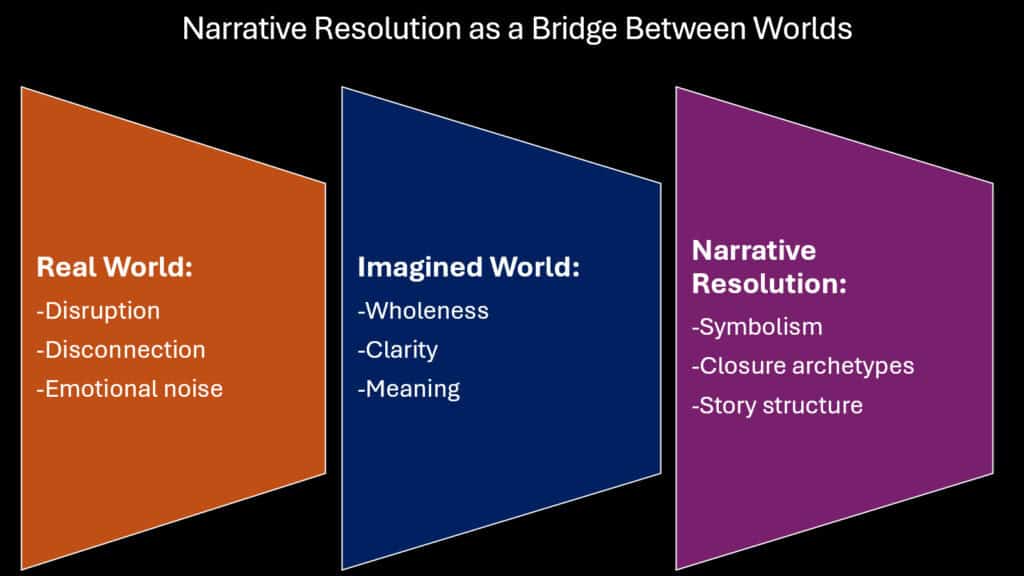
We live in an age of information overload, shortened attention spans, and constant uncertainty. Social media feeds scroll endlessly without resolution. News cycles repeat without conclusion. Relationships begin and end through text messages. In this fragmented landscape, narrative resolution has become more important than ever as a source of psychological stability and emotional coherence.
The six mechanisms explored in this article—cathartic healing, organizational structure, archetypal comfort, internal mirroring, transformational modeling, and boundary creation—all serve the fundamental human need to make sense of experience. Stories don’t just entertain us; they provide the psychological architecture that helps us process emotion, understand growth, and maintain hope despite uncertainty. They offer what the philosopher Paul Ricoeur called “narrative coherence”—the ability to see our lives as meaningful stories rather than random sequences of events.
Yet narrative resolution works precisely because it acknowledges the difference between fictional closure and lived complexity. The best stories provide emotional satisfaction while honoring the ongoing ambiguity that characterizes authentic human experience. They offer templates for understanding growth and change without prescribing simple solutions to complex problems. They create space for catharsis and reflection without encouraging escapism or denial.
As our world becomes increasingly fragmented and uncertain, the psychological function of narrative resolution becomes more crucial. We need stories that model resilience, demonstrate the possibility of growth, and provide emotional containment for experiences that might otherwise overwhelm us. We need endings that satisfy our hunger for closure while preparing us to engage thoughtfully with the beautiful uncertainty of our actual lives.
The act of reading toward resolution remains one of our most powerful tools for psychological development and emotional regulation. In a world that rarely provides clear endings, stories offer the gift of completion—not as an escape from reality, but as preparation for engaging more fully with the ongoing adventure of being human.
| Contemporary Challenges | Narrative Resolution Response | Psychological Benefits |
|---|---|---|
| Information Overload | Provides focused, structured experience | Creates mental clarity and emotional focus |
| Social Fragmentation | Models community and belonging | Reinforces connection and shared humanity |
| Constant Uncertainty | Offers controlled exploration of outcomes | Reduces anxiety through vicarious problem-solving |
| Shortened Attention Spans | Rewards sustained engagement with satisfaction | Rebuilds capacity for deep, meaningful experience |
| Emotional Overwhelm | Creates safe containers for intense feelings | Enables processing without being consumed by emotion |

